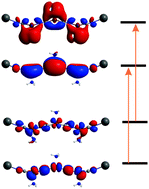Theoretical insights into the effect of amine and phosphine decoration on the photoluminescence of copper(i) and silver(i) coordination polymers
Abstract
Coinage metal cyanides (MCN) form photoluminescent 1D coordination polymers. The decoration of these chains with amine and phosphine ligands shifts the wavelength for photoluminescence into the visible region. Density-functional theory (DFT) and time-dependent DFT (TD-DFT) calculations of zigzag and helical models of decorated chains are used to show that the transitions that contribute to the experimental spectra are related to the π–π excitations previously shown for coinage metal cyanide chains.

- This article is part of the themed collection: Synergy between Experiment and Theory

 Please wait while we load your content...
Please wait while we load your content...